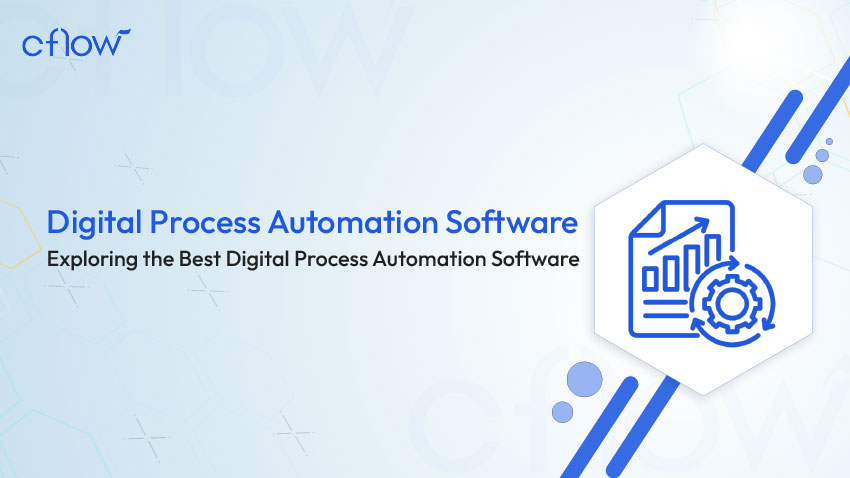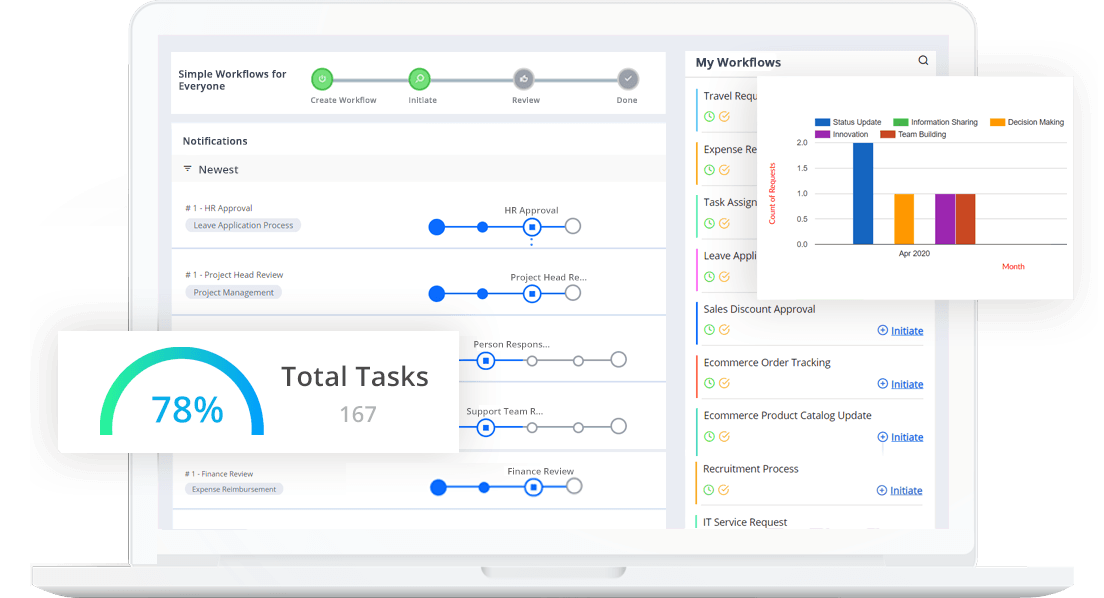Digital Process Automation Software – Exploring the Best Digital Process Automation Software

Key takeaways
- Digital process automation software helps businesses streamline workflows, enhance productivity, and reduce manual effort.
- The best digital process automation software offers scalability, security, and seamless integration with other tools.
- Marketing digital process automation software improves campaign management, customer interactions, and lead nurturing.
- Approval digital process automation software accelerates decision-making by automating document approvals and compliance processes.
- A well-curated best digital process automation software list can help businesses choose the right solution based on their needs.
Introduction
Businesses continually seek ways to optimize their operations and improve efficiency. Digital process automation (DPA) enables organizations to automate workflows, reduce manual interventions, and enhance overall productivity. With the right digital process automation software, companies can streamline repetitive tasks, improve customer experiences, and ensure compliance with industry standards.
The best digital process automation software provides a range of features, including low-code development, AI-powered workflow automation, and cloud-based deployment. For marketing teams, marketing digital process automation software helps automate lead management, email marketing, and campaign tracking. Similarly, the approval of digital process automation software simplifies document approvals, reducing bottlenecks in decision-making processes.
This blog explores digital process automation in detail, covering its principles, differences from business process management, key use cases, benefits, and how businesses can choose the right solution from the best digital process automation software list. We also introduce Cflow as a trusted digital process automation partner and conclude with key takeaways and FAQs.
Table of Contents
What is Digital Process Automation?
Digital process automation (DPA) uses technology to automate complex business workflows, reduce human intervention, and improve operational efficiency. Unlike traditional automation, which focuses on simple task-based automation, DPA is designed to manage end-to-end business processes across departments. It integrates multiple systems, applications, and stakeholders to ensure seamless workflow execution.
DPA is built on the foundation of business process management (BPM) and robotic process automation (RPA), offering a comprehensive approach to workflow optimization. While BPM focuses on process modeling and continuous improvement, DPA emphasizes digitization and automation of processes to enhance agility and responsiveness.
Businesses across industries leverage DPA to improve customer experiences, accelerate decision-making, and ensure compliance with regulatory requirements. From HR onboarding and invoice processing to customer service automation, DPA enables organizations to create smarter, more efficient workflows.
Key Principles of Digital Process Automation
- End-to-End Process Automation: DPA automates entire business processes rather than isolated tasks. It ensures that workflows are streamlined from initiation to completion, eliminating inefficiencies.
- Low-Code/No-Code Development: Modern DPA platforms offer low-code or no-code environments, allowing business users to create and modify workflows without extensive coding knowledge.
- Seamless Integration: DPA solutions integrate with existing enterprise software, including CRM, ERP, and cloud applications, to create a connected ecosystem.
- AI and Machine Learning Capabilities: Advanced DPA tools leverage AI and machine learning to analyze data, predict outcomes, and optimize workflows dynamically.
- User-Centric Approach: DPA enhances user experience by providing intuitive interfaces, role-based access, and mobile-friendly workflow management.
- Compliance and Security: DPA solutions ensure data protection, regulatory compliance, and audit readiness to meet industry standards.
When Do Businesses Need Digital Process Automation?
Businesses should consider adopting DPA when they encounter inefficiencies, high operational costs, and manual errors in their workflows. Key scenarios where DPA becomes essential include:
- Manual and Repetitive Tasks: Automating time-consuming manual processes increases efficiency and reduces errors.
- Slow Approval Processes: Approval digital process automation software speeds up document approvals and ensures compliance.
- Scaling Business Operations: DPA enables businesses to handle increased workloads without additional resources.
- Improving Customer Experience: Faster response times and streamlined interactions enhance customer satisfaction.
- Data-Driven Decision Making: AI-powered DPA tools provide real-time insights and analytics to support strategic decisions.
Digital Process Automation vs Business Process Management
While digital process automation (DPA) and business process management (BPM) are closely related, they differ in their approach and objectives:
- Business Process Management (BPM): BPM is a broader discipline focused on designing, modeling, analyzing, and optimizing business processes to improve overall efficiency and effectiveness. It involves process mapping, governance, performance monitoring, and continuous improvement strategies to ensure that workflows align with business goals.
- Digital Process Automation (DPA): DPA is a subset of BPM that prioritizes digitization and automation of workflows to eliminate manual intervention and enhance speed. It is aimed at improving operational agility, reducing costs, and ensuring process consistency through advanced automation tools.
Key Differences:
- Scope: BPM is a strategic approach encompassing the entire lifecycle of business processes, whereas DPA focuses on automation within those processes.
- Objective: BPM aims at process improvement and efficiency through optimization, while DPA accelerates process execution through automation.
- Technology Usage: BPM involves process design, performance analysis, and workflow reengineering, whereas DPA leverages AI, machine learning, and robotic process automation (RPA) to execute tasks automatically.
- Implementation: BPM may include both manual and automated process improvements, while DPA exclusively relies on digital tools to streamline workflows.
Both BPM and DPA are essential for organizations looking to enhance productivity and efficiency. While BPM provides a structured framework for process management, DPA ensures that those processes are executed swiftly and with minimal human involvement, leading to better business outcomes.
Digital Process Automation vs Business Process Automation
Digital process automation (DPA) and business process automation (BPA) serve different purposes in workflow management:
- Task-Level vs. End-to-End Automation: BPA is designed to automate specific, repetitive tasks within a business process, whereas DPA focuses on the automation of entire workflows, integrating various tasks into a seamless process.
- Rule-Based vs. Intelligent Automation: BPA typically relies on predefined rules and conditions for task execution, while DPA incorporates advanced technologies like artificial intelligence, machine learning, and real-time data analysis to enable adaptive decision-making.
- Flexibility and Scalability: DPA is more adaptable to complex business environments, allowing for dynamic workflow adjustments, whereas BPA is more rigid and suited for straightforward, rule-based processes.
- Integration Capabilities: DPA is designed to integrate with multiple business systems, such as ERP, CRM, and cloud applications, ensuring a cohesive digital transformation. BPA, on the other hand, is often limited to automating isolated tasks without comprehensive system integration.
DPA provides a more strategic approach to process automation, making it ideal for organizations seeking enterprise-wide workflow optimization, whereas BPA is suitable for automating individual tasks with minimal decision-making complexity
Use Cases of Digital Process Automation
- HR Automation: Digital process automation streamlines HR functions such as employee onboarding, leave approvals, and payroll management. Automated workflows reduce paperwork, minimize errors, and ensure timely processing. For instance, an automated onboarding process helps HR teams provide new employees with necessary documentation, training materials, and system access without manual intervention. Leave requests and payroll processing also become seamless, with automated approvals and compliance tracking.
- Finance & Accounting: Automating financial processes like invoice processing, expense approvals, and budget tracking ensures accuracy and efficiency. Instead of relying on manual data entry, digital process automation software captures invoice details, verifies information, and routes them for approvals automatically. This reduces processing time, prevents errors, and enhances compliance with financial regulations. Automated budget tracking provides real-time insights into expenditures, allowing businesses to make informed financial decisions.
- Marketing Automation: Digital process automation improves marketing efficiency by managing campaigns, nurturing leads, and enhancing customer engagement. Businesses can automate repetitive marketing tasks such as email follow-ups, social media scheduling, and customer segmentation. This ensures that leads receive timely and personalized communication, increasing conversion rates. Additionally, automated workflows provide marketing teams with real-time analytics, helping them refine strategies based on data-driven insights.
- Customer Service: Automating customer service processes like ticketing systems, chatbot interactions, and feedback collection enhances response times and service quality. A well-structured digital process automation system routes customer inquiries to the right department, reducing delays. Chatbots powered by automation handle common queries instantly, freeing up customer support agents to focus on complex issues. Automated feedback collection helps businesses analyze customer satisfaction and improve service offerings.
- Compliance & Governance: Organizations must adhere to strict regulatory requirements, and digital process automation ensures seamless compliance management. Automated document approvals, audit trails, and policy enforcement eliminate the risks associated with manual compliance tracking. Businesses can create workflows that enforce policy adherence, ensuring that all actions are logged and auditable. This enhances security, reduces legal risks, and maintains industry standards effortlessly.
Digital process automation transforms various business operations by reducing manual workloads, improving efficiency, and ensuring accuracy. By leveraging automation, organizations can optimize their workflows and focus on strategic growth.
Benefits of Digital Process Automation
- Enhanced Efficiency: Digital process automation eliminates redundant and repetitive tasks by automating them, allowing employees to focus on high-value activities. It streamlines workflows, reduces delays, and increases overall productivity.
- Cost Reduction: By reducing the need for manual intervention, businesses save on labor costs and minimize errors that could lead to financial losses. Automation also decreases paperwork and administrative expenses, leading to long-term cost savings.
- Improved Accuracy: Manual processes are prone to human errors, which can lead to inconsistencies and inefficiencies. Automation ensures precision in data handling, reducing the risk of errors and improving the reliability of business operations.
- Faster Decision-Making: Approval digital process automation software accelerates decision-making by automating approval workflows, reducing bottlenecks, and ensuring that critical tasks are completed without unnecessary delays. Real-time notifications keep decision-makers informed.
- Better Compliance: Organizations need to comply with various regulatory requirements, and digital process automation ensures adherence to industry standards by maintaining audit trails, enforcing security controls, and generating compliance reports.
- Scalability: As businesses grow, so do their operational complexities. Digital process automation provides scalability by handling increasing workloads efficiently. It allows organizations to expand their operations without proportionally increasing manual efforts.
Why is Cflow Your Digital Process Automation Partner?
Cflow is a powerful digital process automation software that helps businesses automate workflows with ease. It is designed to enhance efficiency, streamline operations, and ensure compliance with regulatory standards.
- User-Friendly Interface: No coding is required for workflow automation, making it accessible for users of all skill levels.
- Seamless Integrations: Connects with CRM, ERP, cloud applications, and third-party tools to ensure a smooth workflow experience.
- AI-Driven Automation: Leverages AI and machine learning for optimized workflow execution, data-driven insights, and intelligent decision-making.
- Compliance-Ready: Ensures data security, audit trails, and regulatory adherence to industry standards.
- Cost-Effective: Offers affordable pricing with scalable features to cater to businesses of all sizes.
- Custom Workflow Design: Enables businesses to design, modify, and implement custom workflows tailored to their specific needs.
- Advanced Reporting & Analytics: Provides detailed reports, real-time insights, and performance analytics for better decision-making.
- Cloud-Based & On-Premise Deployment: Offers flexible deployment options to suit varying IT infrastructure requirements.
- Role-Based Access Control: Allows businesses to set user permissions, ensuring secure access and data confidentiality.
- Mobile Access: Enables users to monitor and manage workflows on-the-go via mobile applications.
- Drag-and-Drop Workflow Builder: Simplifies the process of creating workflows without requiring extensive technical knowledge.
- Task and Approval Management: Enhances collaboration by automating approval processes and task assignments within teams.
Cflow’s extensive features make it a reliable choice for organizations seeking a comprehensive digital process automation solution. It provides a balance between simplicity, functionality, and cost-effectiveness, making it suitable for businesses across various industries.
End-to-end workflow automation
Build fully-customizable, no code process workflows in a jiffy.
Top 10 Digital Process Automation Software
Choosing the right digital process automation software is essential for businesses aiming to optimize workflows. Here is a list of the top 10 digital process automation tools available today, with a brief description, key features, and their pros and cons.
Cflow
Cflow is a user-friendly, no-code workflow automation platform that helps businesses streamline approvals, task management, and compliance. It integrates with third-party applications for seamless process automation.
Key Features:
- No-code workflow automation
- Seamless integrations
- Task management
- Compliance tracking
- Cloud-based deployment
Pros:
- Easy to use and highly customizable
- Cost-effective
- Excellent customer support
Cons:
- Limited advanced AI capabilities compared to enterprise solutions
Appian
Appian is a low-code automation tool designed for enterprises to build, automate, and optimize workflows efficiently.
Key Features:
- Low-code development
- Process mining
- AI-driven automation
- Dynamic case management
Pros:
- Scalable and enterprise-ready
- Integrates well with third-party applications
Cons:
- Higher learning curve for new users
Nintex
Nintex provides a robust process automation platform with workflow mapping, analytics, and document automation capabilities.
Key Features:
- Workflow mapping
- Robotic process automation (RPA)
- Document generation
- Analytics and reporting
Pros:
- Powerful workflow automation
- Strong reporting tools
Cons:
- Expensive for small businesses
- Complex setup process
Pega
Pega is an AI-driven digital process automation software that supports workflow optimization, decision automation, and case management.
Key Features:
- AI-driven decision automation
- Omnichannel engagement
- Business rules engine
Pros:
- Excellent AI and analytics capabilities
- Strong customer engagement features
Cons:
- Expensive and complex setup for non-technical users
Bizagi
Bizagi offers a visual workflow design environment and process execution engine for automating business operations.
Key Features:
- Model-driven process automation
- Cloud and on-premise deployment
- Process intelligence and analytics
Pros:
- Strong process modeling capabilities
- Flexible deployment options
Cons:
- Requires technical knowledge for customization
IBM Business Automation Workflow
IBM Business Automation Workflow is an enterprise-grade automation solution designed for complex business processes.
Key Features:
- AI-powered workflows
- Process orchestration
- Case management
Pros:
- Ideal for large enterprises
- Robust security and compliance features
Cons:
- Expensive and requires technical expertise
Microsoft Power Automate
Microsoft Power Automate integrates with the Microsoft ecosystem to provide automated workflows across applications.
Key Features:
- Cloud-based automation
- AI-driven workflows
- Integration with Microsoft 365 and third-party tools
Pros:
- Seamless integration with Microsoft apps
- Intuitive interface for Microsoft users
Cons:
- Limited functionality outside the Microsoft ecosystem
ServiceNow
ServiceNow is a robust automation tool that enhances workflow management for IT service operations and enterprise functions.
Key Features:
- IT service management (ITSM)
- Workflow automation
- Predictive intelligence
Pros:
- Highly customizable for enterprise needs
- AI-powered insights for optimization
Cons:
- Expensive, primarily IT-focused
Zoho Creator
Zoho Creator is a flexible, low-code application builder that enables businesses to automate processes effortlessly.
Key Features:
- Low-code application builder
- Form automation
- Drag-and-drop customization
Pros:
- Affordable and user-friendly
- Great for small businesses
Cons:
- Limited advanced automation features
Automate.io
Automate.io is a cloud-based automation tool designed for integrating multiple applications and streamlining workflows across different platforms.
Key Features:
- Multi-app integration
- Drag-and-drop workflow design
- Pre-built automation templates
- Real-time data syncing
Pros:
- Easy to use with minimal technical expertise required
- Supports a wide range of third-party integrations
Cons:
- Limited capabilities for complex enterprise workflows
These tools provide varying degrees of automation capabilities, from simple task automation to enterprise-grade workflow management. Selecting the right one depends on business needs, scalability, and integration requirements.
Final Thoughts
Digital process automation is essential for businesses looking to improve efficiency, reduce costs, and enhance customer experiences. By choosing the best digital process automation software, organizations can streamline operations and gain a competitive edge. Cflow stands out as a trusted partner, offering intuitive and scalable solutions for diverse business needs.
Ready to transform your business with digital process automation? Explore Cflow today!
FAQs
What industries benefit from digital process automation?
Industries like finance, healthcare, retail, and manufacturing use DPA for workflow optimization.
How does DPA improve efficiency?
By automating repetitive tasks, reducing manual errors, and accelerating decision-making.
Is digital process automation suitable for small businesses?
Yes, modern DPA solutions like Cflow offer scalable and affordable options for SMEs.
What is the difference between RPA and DPA?
RPA automates tasks, while DPA focuses on end-to-end process automation.
How do I choose the best digital process automation software?
Look for features like low-code development, AI integration, and seamless third-party integrations.
What should you do next?
Thanks for reading till the end. Here are 3 ways we can help you automate your business:

Do better workflow automation with Cflow
Create workflows with multiple steps, parallel reviewals. auto approvals, public forms, etc. to save time and cost.

Talk to a workflow expert
Get a 30-min. free consultation with our Workflow expert to optimize your daily tasks.

Get smarter with our workflow resources
Explore our workflow automation blogs, ebooks, and other resources to master workflow automation.
What would you like to do next?
Automate your workflows with our Cflow experts.



